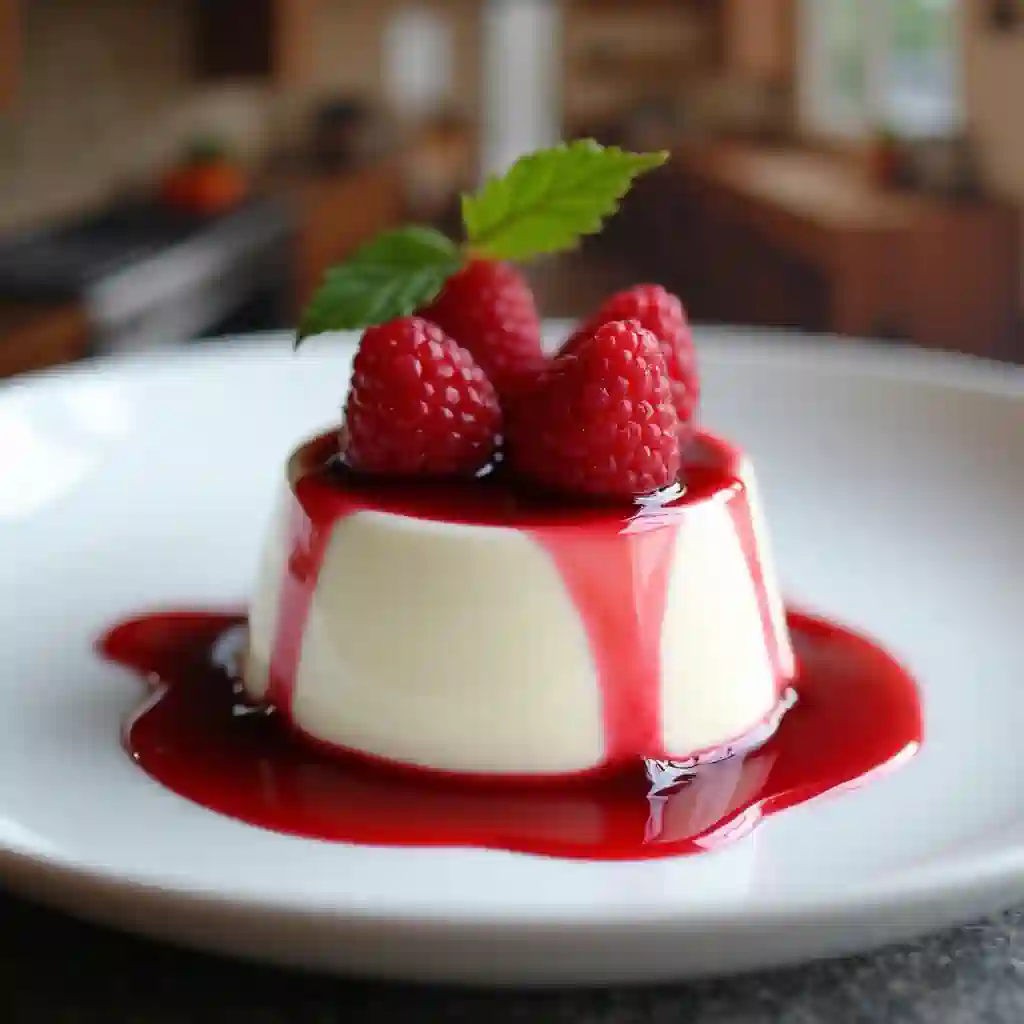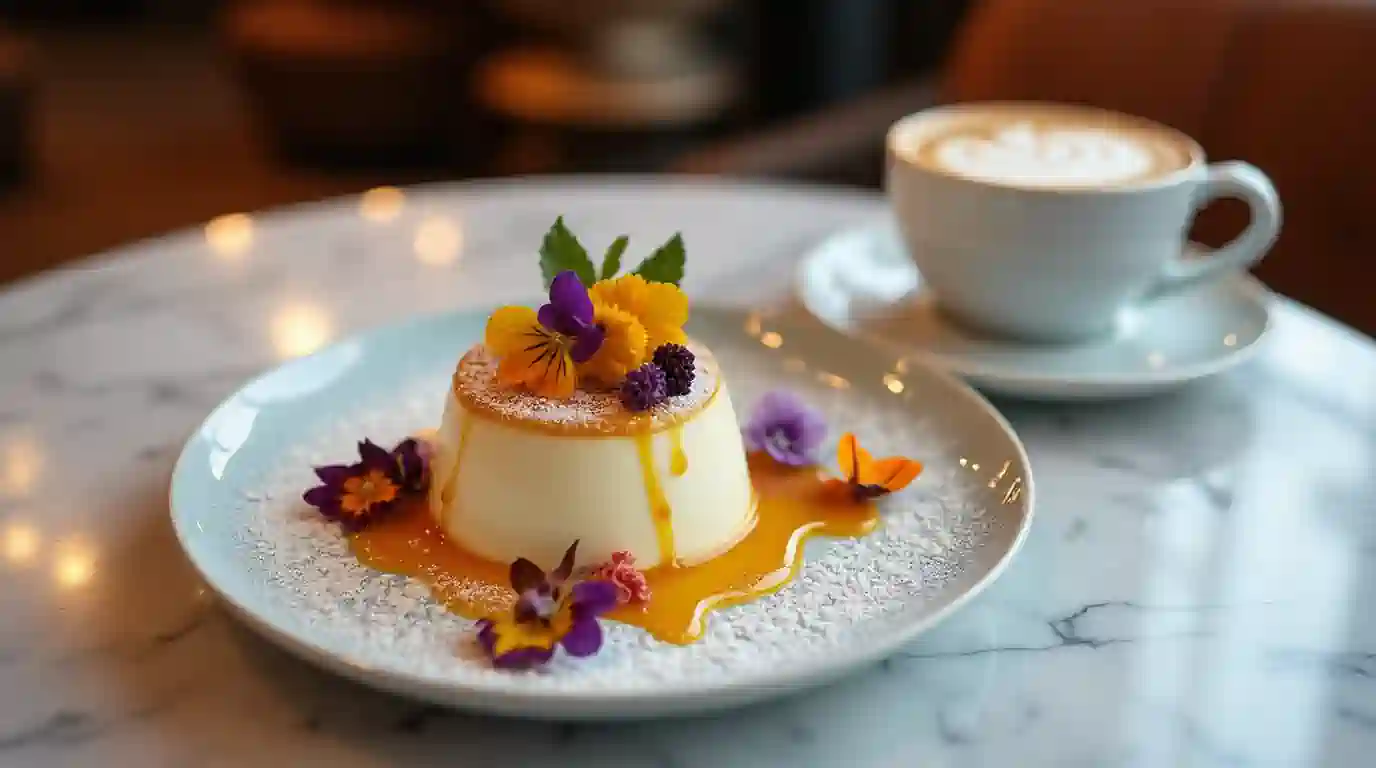Introduction
A panna cotta recipe is one of the easiest ways to create a smooth, creamy, and elegant Italian dessert with minimal effort. This classic dish requires just a few ingredients—cream, sugar, gelatin, and vanilla—to achieve a silky texture that melts in your mouth. Whether you serve it with fresh berries, caramel, or a fruit coulis, panna cotta is the perfect dessert for any occasion.
Table of Contents
This guide will show you:
- How to make panna cotta step by step
- The best ingredients for a rich and creamy texture
- Pro tips for achieving the perfect set
- Delicious flavor variations to try
Now, let’s dive into making this foolproof panna cotta recipe!
Introduction to Panna Cotta
What Is Panna Cotta? A Classic Italian Dessert
Panna cotta translates to “cooked cream” in Italian, and that’s exactly what it is—a simple blend of cream, sugar, and gelatin, gently heated and chilled to form a delicate, custard-like texture. Unlike traditional puddings or custards, panna cotta contains no eggs, making it lighter and smoother.
What makes it special?
- Effortless elegance – It looks fancy but is super easy to prepare.
- Versatile flavors – You can infuse it with vanilla, coffee, chocolate, or fruit.
- Perfect for any occasion – Whether it’s a dinner party or a casual treat, panna cotta fits any setting.
Fun Fact: Panna cotta is often compared to flan or crème brûlée, but it’s much lighter and silkier due to the absence of eggs.
“If you’re looking for a no-fuss dessert that tastes gourmet, panna cotta is the answer!”
Why This Panna Cotta Recipe Stands Out
There are plenty of panna cotta recipes out there, but this one ensures:
- A smooth, lump-free texture – No grainy or rubbery results.
- Perfect balance of sweetness and creaminess – Not too heavy, not too sweet.
- Foolproof gelatin technique – Ensuring the perfect set without over-thickening.
Pro Tip: The key to the best panna cotta is using high-quality cream and pure vanilla extract—they make all the difference.
Quick History of Panna Cotta and Its Origins
Panna cotta’s exact origins are unclear, but it’s believed to have been created in Northern Italy’s Piedmont region in the early 1900s. Traditionally, Italian cooks used fish-based gelatin to thicken the cream, but today, powdered gelatin is the most common setting agent.
Over time, this dessert has evolved into countless variations, from vegan coconut panna cotta to indulgent chocolate and coffee-infused versions.
“While panna cotta is rooted in Italian cuisine, it has become a global favorite, appearing on dessert menus worldwide!”
If you’re interested in other Italian desserts, you may check out their Crème Brûlée Recipe Tips .
Essential Ingredients for the Perfect Panna Cotta
Key Ingredients for a Perfectly Creamy Dessert
A traditional panna cotta recipe is built on simple, high-quality ingredients that come together to create a luxuriously creamy dessert. Here’s what you need:
- Heavy Cream – The base of panna cotta, providing its rich and silky texture.
- Whole Milk – Helps balance the heaviness of the cream, making the dessert light yet creamy.
- Granulated Sugar – Adds sweetness without overpowering the delicate flavors.
- Gelatin – The setting agent that gives panna cotta its signature jiggle.
- Vanilla Extract or Vanilla Bean – Infuses the dessert with a warm, aromatic flavor.
🔥 Pro Tip: For the most authentic Italian flavor, use real vanilla bean instead of extract.
“The secret to the best panna cotta is using the freshest, highest-quality dairy and a light hand with gelatin.”
How Gelatin Affects the Texture of This Dessert
Gelatin is what gives panna cotta its light, wobbly consistency. However, too much gelatin can make it stiff and rubbery, while too little can leave it too soft to hold its shape.
To get it right:
- Use the correct gelatin-to-liquid ratio – About 1 teaspoon of powdered gelatin per cup of liquid.
- Bloom the gelatin properly – Soak it in cold water for 5 minutes before adding it to warm cream.
- Avoid overheating the gelatin – High heat destroys its setting properties.
🔥 Pro Tip: If using sheet gelatin, soak it in cold water until soft, then squeeze out excess water before adding it to the warm cream.
“The difference between perfect panna cotta and a rubbery mess comes down to mastering the gelatin technique.”
Choosing the Best Dairy for Creamy Panna Cotta
Not all dairy is equal when it comes to making the perfect panna cotta. Here’s what works best:
- Traditional Version: Use heavy cream and whole milk for a rich but balanced texture.
- Lighter Version: Swap half of the cream for half-and-half or whole milk.
- Dairy-Free Alternative: Use coconut milk or almond milk, but expect a slightly different consistency.
🔥 Pro Tip: If making dairy-free panna cotta, use agar-agar instead of gelatin, as gelatin is derived from animal sources.
Step-by-Step Instructions for Making Panna Cotta

Preparing the Gelatin: The Secret to a Smooth Set
Before anything else, properly blooming the gelatin ensures your panna cotta recipe turns out smooth and lump-free.
- Measure the gelatin – Use 1 teaspoon of powdered gelatin per cup of liquid.
- Sprinkle over cold water – Let it sit for 5-10 minutes to absorb moisture.
- Dissolve gently – Never add gelatin to boiling liquid, or it won’t set properly.
🔥 Pro Tip: If your gelatin forms clumps, strain the mixture before chilling.
“Blooming gelatin is the key step that separates a silky panna cotta from a lumpy one!”
Heating the Cream: Achieving the Perfect Consistency
- In a saucepan, combine heavy cream, milk, and sugar.
- Heat over medium-low, stirring frequently to prevent scorching.
- Do not let it boil! The mixture should be warm but not bubbling.
🔥 Pro Tip: To check if it’s ready, dip a spoon in—if the back of the spoon is coated, it’s perfectly heated.
Combining Ingredients and Pouring into Molds
- Remove the cream mixture from heat and stir in bloomed gelatin.
- Whisk until fully dissolved, making sure there are no lumps.
- Strain through a fine-mesh sieve for an ultra-smooth consistency.
- Divide into ramekins or silicone molds.
🔥 Pro Tip: Let panna cotta cool slightly before refrigerating to prevent condensation on the surface.
“Straining the mixture ensures a restaurant-quality silky texture in every bite!”
Chilling Time: How Long Should Panna Cotta Set?
A perfect panna cotta recipe requires at least 4 hours of chilling, but overnight is best for full flavor development.
- Cover each ramekin with plastic wrap to prevent absorbing fridge odors.
- Refrigerate for 4-6 hours until fully set.
- To test if it’s ready, lightly shake the ramekin—it should have a slight jiggle but hold its shape.
🔥 Pro Tip: Never rush panna cotta by freezing it, as this can cause separation and a grainy texture.
Demolding Panna Cotta Without Breaking It
Removing panna cotta from the mold can be tricky, but these steps help:
- Dip the ramekin in warm water for 5-10 seconds to loosen the edges.
- Run a thin knife along the edge if necessary.
- Invert onto a plate and gently shake—it should slide out smoothly.
🔥 Pro Tip: Silicone molds are easier to use than glass ramekins for perfect demolding.
“A panna cotta that releases cleanly is a sign of a perfectly set dessert!”
Panna Cotta Variations & Flavors
A panna cotta recipe is incredibly versatile, allowing for endless flavor possibilities. Whether you prefer a classic vanilla version or something more adventurous like chocolate or fruit-infused, there’s a panna cotta for every occasion.
Classic Vanilla Version – A Timeless Favorite
The most traditional panna cotta is flavored with pure vanilla, creating a smooth, aromatic dessert.
To enhance the flavor:
- Use real vanilla beans instead of extract for a rich, natural taste.
- Let the mixture sit for 30 minutes before chilling to intensify the vanilla flavor.
- Serve with fresh berries or a drizzle of honey for a simple yet elegant dessert.
🔥 Pro Tip: Scrape the vanilla bean pod into the cream for a beautiful speckled look and deeper flavor.
“Sometimes, the simplest desserts are the most elegant—classic vanilla panna cotta is proof of that!”
Chocolate Panna Cotta – A Decadent Twist
For a more indulgent version, chocolate panna cotta is a perfect choice.
How to make it:
- Add ½ cup of melted dark chocolate to the cream mixture.
- Reduce sugar slightly to balance the sweetness.
- Top with chocolate shavings or cocoa powder for extra richness.
🔥 Pro Tip: Use bittersweet chocolate for a more intense, luxurious flavor.
“Chocolate lovers, this silky-smooth panna cotta is your new favorite dessert!”
Berry Panna Cotta with Fresh Fruit Compote
A light and refreshing variation, berry panna cotta pairs perfectly with summer fruits.
How to make it:
- Replace half of the cream with pureed strawberries, raspberries, or blueberries.
- Add a splash of lemon juice to enhance the fruit’s natural flavor.
- Serve with a homemade berry compote for an extra burst of freshness.
🔥 Pro Tip: Strain the fruit puree before adding it to the cream to ensure a smooth texture.
Coconut Panna Cotta – A Dairy-Free Alternative
For those who are lactose intolerant or vegan, coconut panna cotta is a delicious alternative.
How to make it:
- Substitute coconut milk for heavy cream.
- Use agar-agar instead of gelatin for a fully plant-based version.
- Serve with toasted coconut flakes for extra flavor.
🔥 Pro Tip: A pinch of salt enhances the coconut’s natural sweetness.
“Who said dairy-free desserts can’t be creamy? This coconut panna cotta is proof otherwise!”
Gordon Ramsay’s Panna Cotta – What Makes It Special?
Celebrity chef Gordon Ramsay’s panna cotta is known for its light, delicate texture and intense vanilla flavor. His secret?
- Using half milk, half cream for a balanced texture.
- Blooming gelatin in lemon-infused water for a subtle citrus note.
- Serving with a tart berry sauce to contrast the sweetness.
🔥 Pro Tip: Don’t skip the lemon zest infusion—it enhances the flavors beautifully.
“If you want restaurant-quality panna cotta, follow Gordon Ramsay’s refined techniques!”
Serving and Presentation Ideas
A panna cotta recipe isn’t just about taste—it’s also about presentation. The right garnishes, toppings, and plating techniques can turn this simple dessert into a show-stopping masterpiece.

How to Garnish Panna Cotta for an Elegant Look
An elegant dessert deserves a beautiful presentation. Some easy yet stunning garnishes include:
- Fresh berries (strawberries, raspberries, or blackberries) for a pop of color.
- Edible flowers like lavender or pansies for a sophisticated touch.
- Chocolate curls or cocoa powder for a rich, indulgent look.
- Caramel drizzle or honey for a glossy, golden finish.
🔥 Pro Tip: Use a contrast of textures—like crunchy nuts or silky sauces—for the best presentation.
“A well-garnished panna cotta looks just as good as it tastes!”
Best Sauces and Toppings: Caramel, Berries, and Nuts
The right sauce can enhance the flavor of your panna cotta. Some excellent options include:
- Berry Compote: Made by simmering berries with sugar and lemon juice.
- Salted Caramel Sauce: Adds a rich, buttery depth of flavor.
- Dark Chocolate Ganache: Perfect for chocolate lovers.
- Toasted Nuts & Crushed Cookies: For added crunch and texture.
🔥 Pro Tip: Serve panna cotta with a sauce on the side so guests can control the sweetness.
Pairing Panna Cotta with Wines or Coffee
A beautifully plated panna cotta pairs wonderfully with:
- Espresso or cappuccino for an authentic Italian experience.
- Sweet dessert wines like Moscato or Riesling.
- Champagne or Prosecco for an elegant touch at special occasions.
🔥 Pro Tip: A slightly tart pairing, like espresso or citrus sauce, balances the sweetness of panna cotta.
“Pairing the right drink with panna cotta takes the dining experience to the next level!”
If you’re interested in other classic Italian desserts, you might enjoy their: Crab Brulee Recipe
Common Mistakes and How to Fix Them
Even though a panna cotta recipe is relatively simple, there are a few common mistakes that can ruin the texture, flavor, or presentation. Here’s how to avoid them and fix any issues.
Why Is My Panna Cotta Too Soft or Too Firm?
Getting the right consistency is all about balancing the gelatin-to-liquid ratio.
- If your panna cotta is too soft, you may have used too little gelatin or didn’t allow enough chilling time.
- If it’s too firm, you likely added too much gelatin, making it rubbery.
How to fix it:
- Use 1 teaspoon of gelatin per cup of liquid for the perfect set.
- Always bloom gelatin properly before adding it to the cream mixture.
- Let it chill for at least 4-6 hours, preferably overnight.
🔥 Pro Tip: If you want a lighter, softer panna cotta, reduce the gelatin slightly and increase the milk-to-cream ratio.
“The perfect panna cotta should be delicate, not stiff. A gentle wobble is the goal!”
How to Prevent Lumps in Panna Cotta
Lumps form when gelatin doesn’t dissolve properly or when the mixture is heated too quickly.
How to fix it:
- Bloom gelatin in cold water for 5 minutes before adding it to warm liquid.
- Never let the cream boil—heat it gently over medium-low heat.
- Always strain the mixture through a fine sieve before pouring into molds.
🔥 Pro Tip: Stir continuously while adding the gelatin to prevent clumps.
Fixing Panna Cotta That Won’t Set Properly
If your panna cotta is still liquid after chilling, check these factors:
- Did you bloom the gelatin correctly? It won’t work if added directly to hot liquid.
- Did you chill it long enough? It needs at least 4 hours in the fridge.
- Did you use enough gelatin? A weak ratio won’t provide a firm set.
“Panna cotta takes patience—don’t rush the chilling process!”
FAQs About Panna Cotta
A great panna cotta recipe can raise a few questions. Here are some of the most common ones, along with expert answers.
What Are the Ingredients in Panna Cotta?
A traditional panna cotta recipe uses only a handful of ingredients:
- Heavy cream for richness
- Whole milk for balance
- Gelatin to create the signature set
- Sugar for sweetness
- Vanilla extract or vanilla bean for flavor
Some variations include fruit purees, coffee, or chocolate to switch up the flavors.
What Is Italian Panna Cotta Made Of?
Italian panna cotta follows the same classic formula:
- Fresh dairy (cream and milk) mixed with sugar
- Gelatin dissolved in the warmed cream mixture
- Chilled in molds until set
It’s traditionally served with berries, caramel, or a light sauce.
🔥 Pro Tip: Italians often use vanilla beans instead of extract for an authentic, aromatic flavor.
How Do You Make Gordon Ramsay’s Panna Cotta?
Gordon Ramsay’s panna cotta is known for being light, silky, and perfectly balanced. His technique includes:
- Using half cream and half milk for a more delicate texture
- Blooming gelatin in lemon-infused water for added depth
- Straining the mixture twice for extra smoothness
- Serving with a tangy berry compote to balance the sweetness
🔥 Pro Tip: For a restaurant-quality finish, serve panna cotta in clear glasses or shallow bowls.
What Does Panna Cotta Taste Like?
A classic panna cotta recipe has a mild, creamy, and slightly sweet flavor, similar to:
- Vanilla pudding but silkier
- Flan but without the eggy taste
- Crème brûlée without the caramelized top
The taste depends on the flavoring used—vanilla is most common, but coffee, chocolate, or fruit versions each have a unique twist.
🔥 Pro Tip: Pair panna cotta with a tart sauce, like raspberry or passion fruit, to enhance the richness.
Conclusion – Why You Should Try This Panna Cotta Recipe
A great panna cotta recipe delivers a smooth, creamy, and elegant dessert with minimal effort. Whether you’re making the classic vanilla version or experimenting with chocolate, fruit, or dairy-free alternatives, panna cotta is versatile and foolproof when done right.
Mastering the gelatin technique, choosing the best dairy, and chilling it properly ensures success every time. Plus, with endless topping and serving options, you can tailor it to any occasion.
Now that you know all the secrets to the perfect panna cotta, it’s time to gather your ingredients and start creating your own masterpiece!
“Once you try homemade panna cotta, you’ll never settle for anything less!”
For more creative baking ideas, check out our guide on
- Smoked Meatloaf Recipe: How To Make
- Banana Bread Recipe with Cake Mix
- The Ultimate Velveeta Mac and Cheese Recipe – Creamy & Delicious
- Star Anise: A Comprehensive Guide to Its Uses, Benefits, and Culinary Magic
- How To Make Simple Banana Bread: Tips And Tricks
- What Makes Gruyère Cheese Special? A Complete Guide

